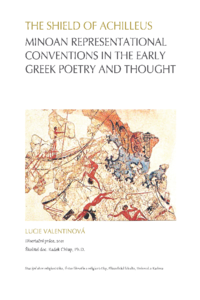The Shield of Achilles: Minoan Representational Conventions in Early Greek Poetry and Thought
Achilleův štít: Minójské zobrazovací postupy v archaické řecké poezii a myšlení
dizertační práce (OBHÁJENO)

Zobrazit/
Trvalý odkaz
http://hdl.handle.net/20.500.11956/152451Identifikátory
SIS: 182198
Kolekce
- Kvalifikační práce [24991]
Autor
Vedoucí práce
Oponent práce
Hladký, Vojtěch
Thein, Karel
Fakulta / součást
Filozofická fakulta
Obor
Religionistika
Katedra / ústav / klinika
Ústav filosofie a religionistiky
Datum obhajoby
30. 9. 2021
Nakladatel
Univerzita Karlova, Filozofická fakultaJazyk
Angličtina
Známka
Prospěl/a
Klíčová slova (česky)
Mínójské fresky|Achilleův štít|Nenarativní zobrazování|Vertikální perspektiva|Hledisko diváka|Fokalizace|AnaximandrosKlíčová slova (anglicky)
Minoan Frescoes|Shield of Achilles|Non-narrative representations|Vertical Perspective|Point of View|Focalisation|AnaximanderPředkládaná práce se zabývá Homérovým popisem Achilleova štítu (Ílias 18.478-608) a mínójskou freskovou malbou, zejména miniaturními freskami z Knóssu, takzvanými vyobrazeními posvátného háje a tance (Sacred Grove and Dance Fresco) a shromáždění diváků (Grandstand Fresco). Prostřednictvím analýzy jejich zobrazovacích postupů zkoumá možnosti sledování kulturního přenosu mezi dvěma civilizacemi, které preferovaly odlišná reprezentační media: malbu v případě vizuálně orientované mínójské civilizace doby bronzové a poezii v nejstarších kulturních vrstvách starověkého Řecka. Protože v případě mínójské kultury nemáme k dispozici rozluštěné písemné prameny a její fresková malba byla, jak práce ukazuje, převážně nenarativní, k jejím tématům si obtížně zjednáváme přístup. Ukazuje se nicméně, že nemálo se můžeme dozvědět z interpretace toho, jak techniky zobrazení v malířství i poezii zacházejí s reprezentací časových a prostorových vztahů, a ze vztahu, jaký navazují se svým divákem a posluchačem; jeví-li se nám svět jako složitý komplex kulturních reprezentací, způsob, jakým se k nim vztahujeme, odráží naši představu o lidském místě ve světě. Nenarativní zobrazovací postupy mínójských fresek - zejména vertikální perspektivu, absenci pevného hlediska diváka, potlačenou fokalizaci a mapovitou kompozici -...
The present thesis examines Homer's description of the Shield of Achilleus and Minoan miniature frescoes, particularly the Sacred Grove and Dance Fresco and Grandstand Fresco. It uses them as examples to explore the transmission of ideas between cultures - the intensely visual Minoan civilisation of the Bronze Age centred on Crete and the earliest cultural strata of ancient Greece - that preferred different means of representation, painting, and poetry. Because Minoan fresco painting was essentially non-narrative and not accompanied by readable written records, so that "deciphering" its iconography is not an option, the thesis argues that we can learn about general cultural perceptions from interpreting and analysing how techniques of representation in painting and poetry treat the representation of time and space. From the relationship that these techniques establish with the beholders of the representation, we can infer their self-understanding. If the world appears to us as an intricate complex of cultural representations, the way we interact with them reflects our sense of our human place in the world. The non-narrative techniques of Minoan frescoes - particularly the use of vertical perspective, the absence of a fixed point of view, suppressed focalisation, and map-like composition - are shown...
